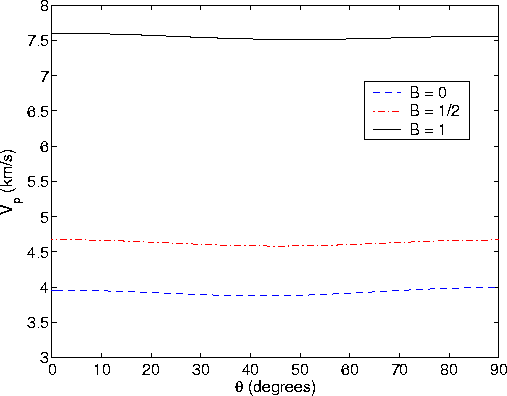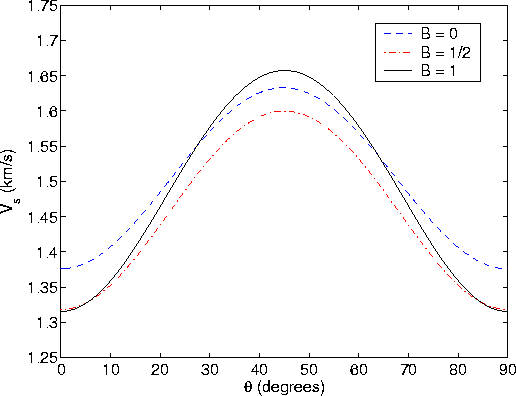From previous work (Berryman, 2003), we know that large fluctuations in the layer shear moduli are required before significant deviations from Gassmann's quasi-static constant result, thereby showing that the shear modulus dependence on fluid properties can become noticeable. To generate a model that demonstrates these results, again I made use of the same code of V. Grechka as described when presenting Figure 1. But this time I arbitrarily picked just one of the models that seemed to be most interesting for the present purposes. The parameters of this model are displayed in TABLE 1. The results for the various elastic coefficients and Thomsen parameters are displayed in TABLE 2. The results of the calculations for Vp and Vsv are shown in Figures 1 and 2.
The model calculations were simplified in one way: the value of the
Biot-Willis parameter was chosen to be a uniform value of
![]() in all layers. We could have actually computed a value of
in all layers. We could have actually computed a value of
![]() from the other layer parameters, but to do so would require
another assumption about the porosity values in each layer. Doing this
seemed an exercise of little value because we are just trying to show
in a simple way that the formulas given here really do produce the
types of results predicted analytically, and also to get a feeling for
the magnitude of the effects. Furthermore, if
from the other layer parameters, but to do so would require
another assumption about the porosity values in each layer. Doing this
seemed an exercise of little value because we are just trying to show
in a simple way that the formulas given here really do produce the
types of results predicted analytically, and also to get a feeling for
the magnitude of the effects. Furthermore, if ![]() is a constant, then
it is only the product
is a constant, then
it is only the product ![]() that matters. Whatever choice of
constant
that matters. Whatever choice of
constant ![]() is made, it mainly determines the maximum value of the
product
is made, it mainly determines the maximum value of the
product ![]() for B in the range [0, 1]. So, for a parameter
study, it is only important not to choose too a small value of
for B in the range [0, 1]. So, for a parameter
study, it is only important not to choose too a small value of ![]() ,which is why the choice
,which is why the choice ![]() was made. This means that the
maximum amplification of the bulk modulus due to fluid effects can be
as high as a factor of 5 [
was made. This means that the
maximum amplification of the bulk modulus due to fluid effects can be
as high as a factor of 5 [![]() ] for the present examples.
] for the present examples.
| Constituent | K (GPa) | z (m/m) | |
| 1 | 9.4541 | 0.0965 | 0.477 |
| 2 | 14.7926 | 4.0290 | 0.276 |
| 3 | 43.5854 | 8.7785 | 0.247 |
| Elastic Parameters | Case | Case | Case |
| and Density | B = 0 | B = 1 | |
| a (GPa) | 33.8345 | 50.3523 | 132.7003 |
| c (GPa) | 33.1948 | 50.4715 | 134.2036 |
| f (GPa) | 22.2062 | 38.5857 | 120.7006 |
| l (GPa) | 4.0138 | 4.0138 | 4.0138 |
| m (GPa) | 6.7777 | 6.7777 | 6.7777 |
| Geff (GPa) | 5.2797 | 5.8841 | 6.2417 |
| -0.0847 | -0.0733 | -0.0399 | |
| 0.0943 | 0.0745 | 0.0343 | |
| 0.3443 | 0.3443 | 0.3443 | |
| 2120.0 | 2310.0 | 2320.0 |
We took the porosity to be ![]() , and the overall density to be
, and the overall density to be
![]() , where
, where
![]() kg/m3, S is liquid saturation
(
kg/m3, S is liquid saturation
(![]() ), and
), and ![]() kg/m3. Then,
three cases were considered: (1) Gas saturation S=0 and
B=0, which is also the drained case, assuming that the effect of
the saturating gas on the moduli is negligible.
(2) Partial liquid saturation S = 0.95 and
kg/m3. Then,
three cases were considered: (1) Gas saturation S=0 and
B=0, which is also the drained case, assuming that the effect of
the saturating gas on the moduli is negligible.
(2) Partial liquid saturation S = 0.95 and ![]() [which is
intended to model a case of partial liquid saturation], intermediate
between the other two cases. For smaller values of liquid saturation, the
effect of the liquid might not be noticeable, since the gas-liquid
mixture when homogeneously mixed will act much like the pure gas in
compression, although the density effect will still be present.
When the liquid fills most of the pore-space, and the gas occupies
less than about
[which is
intended to model a case of partial liquid saturation], intermediate
between the other two cases. For smaller values of liquid saturation, the
effect of the liquid might not be noticeable, since the gas-liquid
mixture when homogeneously mixed will act much like the pure gas in
compression, although the density effect will still be present.
When the liquid fills most of the pore-space, and the gas occupies
less than about ![]() of the entire volume of the rock, the gas starts
to become disconnected, and we expect the effect of the liquid to start
becoming more noticeable, and therefore we choose
of the entire volume of the rock, the gas starts
to become disconnected, and we expect the effect of the liquid to start
becoming more noticeable, and therefore we choose
![]() to be representative of this case.
And, finally, (3) full liquid saturation S = 1 and B=1, which is
also the fully undrained case. We assume for the purposes of this example
that a fully saturating liquid has the maximum possible
stiffening effect on the locally microhomogeneous, isotropic,
poroelastic medium.
to be representative of this case.
And, finally, (3) full liquid saturation S = 1 and B=1, which is
also the fully undrained case. We assume for the purposes of this example
that a fully saturating liquid has the maximum possible
stiffening effect on the locally microhomogeneous, isotropic,
poroelastic medium.
 |
 |
The results shown in Figures 2 and 3 are in complete qualitative and quantitative agreement with the analytical predictions described, as expected.